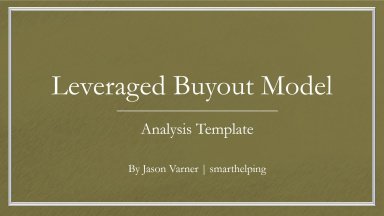
Originally published: 13/09/2023 08:44
Last version published: 08/01/2024 09:26
Publication number: ELQ-14901-2
View all versions & Certificate
Last version published: 08/01/2024 09:26
Publication number: ELQ-14901-2
View all versions & Certificate

15-Year Leveraged Buyout Model (LBO)
Run a financial feasibility analysis on a target company to see what type of leverage the expected operating cash flows can support.
lboleveraged buyoutacquisitionfinancial modelstatement modelfinancial projectionprivate equityventure capital
Description
An LBO (Leveraged Buyout) financial model template serves several critical purposes in the realm of finance, particularly in the private equity sector. Here's what makes such a template useful:
Evaluation of Investment Potential: An LBO model helps investors assess whether a particular company is a suitable target for a leveraged buyout transaction. By inputting various financial assumptions and metrics, investors can project how the company will perform under new capital structure and potential operational improvements.
Determination of Purchase Price: The model allows investors to gauge the maximum price they can pay for a company and still achieve their targeted return on investment.
Capital Structure Analysis: An LBO model provides insights into how much debt a company can handle and what the optimal mix of debt and equity might be for the acquisition. This assists in determining how the buyout will be financed.
Returns Analysis: Investors can use the LBO model to forecast potential returns to equity holders. By tweaking various assumptions, such as the exit multiple or operating performance, they can also assess the sensitivity of their returns to these changes.
Cash Flow Forecasting: The model enables a projection of the company's cash flows, which is essential to ensure that the company can service its debt and provide returns to equity holders.
Scenario Analysis: Investors can run multiple scenarios (e.g., best-case, base-case, worst-case) to understand potential outcomes and risks associated with the investment.
Operational Improvements: Many LBO transactions involve plans to improve the operations of the target company. The LBO model can incorporate various operational improvements and their potential financial impacts.
Debt Amortization: An LBO model typically includes a detailed debt schedule that shows how the acquisition-related debt will be paid down over time, taking into account principal repayments, interest costs, and potential refinancings.
Benchmarking and Comparisons: Investors can compare the target company's metrics and performance against industry peers or previous LBO transactions to ensure they are making a sound investment decision.
Communication Tool: For investment teams, the LBO model is a tool to communicate the investment thesis, risks, and potential returns to internal stakeholders, financiers, and even to the management team of the target company.
In essence, an LBO financial model template is a foundational tool in the private equity sector, allowing professionals to project, analyze, and communicate the nuances of potential investments and strategies. Given the large amounts of capital and the high stakes involved in these transactions, having a robust and comprehensive LBO model is essential.
This template is also included in one bundle:
- All Models Bundle: https://www.eloquens.com/tool/P8Y4TX4v/finance/financial-forecasting-models/financial-models-120-useful-and-usable-logic
An LBO (Leveraged Buyout) financial model template serves several critical purposes in the realm of finance, particularly in the private equity sector. Here's what makes such a template useful:
Evaluation of Investment Potential: An LBO model helps investors assess whether a particular company is a suitable target for a leveraged buyout transaction. By inputting various financial assumptions and metrics, investors can project how the company will perform under new capital structure and potential operational improvements.
Determination of Purchase Price: The model allows investors to gauge the maximum price they can pay for a company and still achieve their targeted return on investment.
Capital Structure Analysis: An LBO model provides insights into how much debt a company can handle and what the optimal mix of debt and equity might be for the acquisition. This assists in determining how the buyout will be financed.
Returns Analysis: Investors can use the LBO model to forecast potential returns to equity holders. By tweaking various assumptions, such as the exit multiple or operating performance, they can also assess the sensitivity of their returns to these changes.
Cash Flow Forecasting: The model enables a projection of the company's cash flows, which is essential to ensure that the company can service its debt and provide returns to equity holders.
Scenario Analysis: Investors can run multiple scenarios (e.g., best-case, base-case, worst-case) to understand potential outcomes and risks associated with the investment.
Operational Improvements: Many LBO transactions involve plans to improve the operations of the target company. The LBO model can incorporate various operational improvements and their potential financial impacts.
Debt Amortization: An LBO model typically includes a detailed debt schedule that shows how the acquisition-related debt will be paid down over time, taking into account principal repayments, interest costs, and potential refinancings.
Benchmarking and Comparisons: Investors can compare the target company's metrics and performance against industry peers or previous LBO transactions to ensure they are making a sound investment decision.
Communication Tool: For investment teams, the LBO model is a tool to communicate the investment thesis, risks, and potential returns to internal stakeholders, financiers, and even to the management team of the target company.
In essence, an LBO financial model template is a foundational tool in the private equity sector, allowing professionals to project, analyze, and communicate the nuances of potential investments and strategies. Given the large amounts of capital and the high stakes involved in these transactions, having a robust and comprehensive LBO model is essential.
This template is also included in one bundle:
- All Models Bundle: https://www.eloquens.com/tool/P8Y4TX4v/finance/financial-forecasting-models/financial-models-120-useful-and-usable-logic
This Best Practice includes
1 Excel model and 1 Tutorial Video
Further information
Perform an acquisition analysis of a target company.
Up to 15 year hold with debt / equity usage.





























